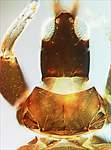
australis female

ficorum female

australis head

ficorum

uzeli

luzonensis

jasmini

platypodae

australis pronotum

platypodae antenna

australis antennal segments III-IV

uzeli pronotum

ficorum pronotum

platypodae pronotum

ficorum metanotum & pelta

australis metanotum

australis pelta

platypodae prosternites

australis fore wing base

australis tergite III

uzeli male sternite VIII

insulsus male tergite VIII

insulsus male sternite VIII

luzonensis male tergite VIII
Generic diagnosis
Medium to large, macropterous Phlaeothripinae usually with strong pronotal sculpture. Head longer than wide; postocular setae variable, usually 1 pair but often 2 (sometimes 0); genae not constricted at base; mouth-cone short and broadly rounded; maxillary stylets usually not retracted to postocular setae, about one third of head width apart; maxillary bridge absent. Antennae 8-segmented; segment III with 1 sense cone, IV with 3 sense cones; VIII not strongly constricted at base. Pronotum with complex reticulate sculpture; notopleural sutures complete or incomplete; major setae variable in lengths but at least epimeral setae long. Prosternal basantra absent or weakly developed, ferna large, mesopresternum complete; metathoracic sternopleural sutures absent. Fore tarsal tooth present in both sexes but sometimes very small. Fore wings not constricted medially, with duplicated cilia. Pelta triangular, reticulate; tergites II‒VII each with 2 pairs of sigmoid wing-retaining setae, sometimes with curved or straight accessory wing-retaining setae laterally; tergite IX setae long and pointed but shorter than tube; tube slightly longer than head, anal setae shorter than tube. Male tergite IX setae S2 short and stout; sternite VIII with pore plate.
Nomenclatural data
Gynaikothrips Zimmermann, 1900: 13. Type species Gynaikothrips uzeli Zimmermann, 1900, by monotypy.
There are 39 species listed in this genus (ThripsWiki, 2022).
Australian species
Gynaikothrips australis Bagnall, 1929: 187
Gynaikothrips ficorum (Marchal, 1908: 252)
Gynaikothrips insulsus Priesner, 1939: 481
Gynaikothrips jasmini Mound & Tree, 2021: 545
Gynaikothrips luzonensis Priesner, 1939: 480
Gynaikothrips platypodae Mound & Tree, 2021: 546
Gynaikothrips uzeli Zimmermann, 1900: 12
Relationship data
This genus is a typical member of the Liothrips-lineage of Phlaeothripinae, but the name has a confusing nomenclatural origin. Zimmermann described the type species (1900: 12) as the first of five species in a new genus Mesothrips, but he illustrated it (1900: 13) as the only species in a new genus Gynaikothrips.
Distribution data
The species in this genus are widespread in the Asian tropics. Three species are considered to be Australian endemics, two are widespread in association with cultivated Ficus species, and two Asian species are known from sub-tropical northern Australia.
Biological data
These are gall-inducing species on leaves, particularly of Ficus species but with one Australian species on Jasminum simplicifolium.
References
Mound LA & Tree DJ (2021) Taxonomic problems with Gynaikothrips and related genera (Thysanoptera, Phlaeothripinae): the ficorum/uzeli complex and taxa endemic to Australia. Zootaxa 5023 (4): 537–554.
Tree DJ & Walter GH (2009) Diversity of host plant relationships and leaf galling behaviours within a small genus of thrips – Gynaikothrips and Ficus in south east Queensland. Australian Journal of Entomology 48: 269–275.
Tree DJ, Mound LA & Field AR (2015) Host specificity studies on Gynaikothrips (Thysanoptera:Phlaeothripidae) associated with leaf galls of cultivated Ficus (Rosales: Moraceae) trees. Florida Entomologist 98(3): 880–883.
ThripsWiki (2022) ThripsWiki - providing information on the World's thrips. Available from: http://thrips.info/wiki/ (Accessed 15.iii.2022)
Zimmerman A (1900) Über einige javanische Thysanopteren. Bulletin de l’Insitut Botanique de Buitenzorg Java 7: 6–19.